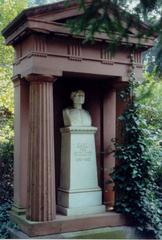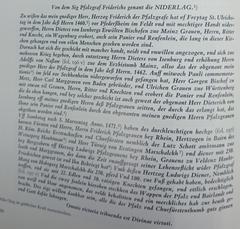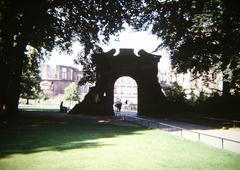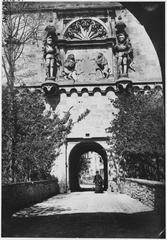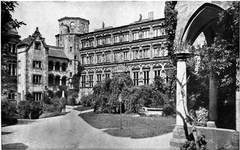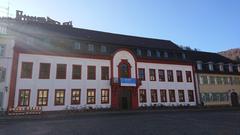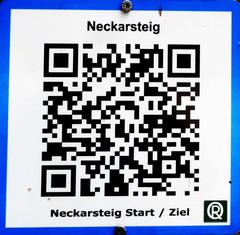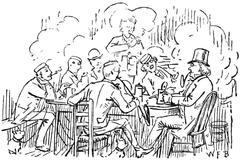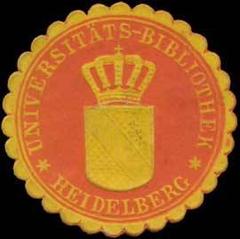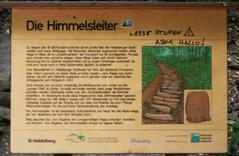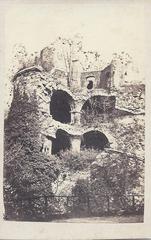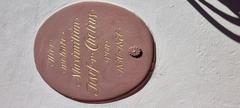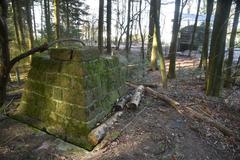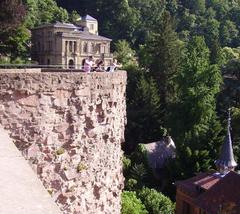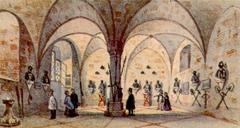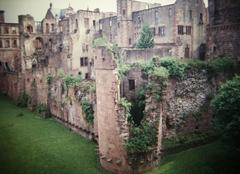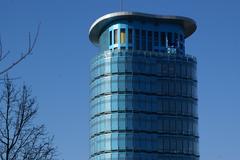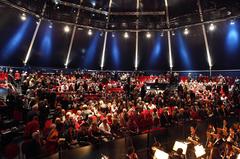KDStV Arminia Heidelberg: Visiting Hours, Tickets, and Comprehensive Guide to Heidelberg’s Historic Student Fraternity
Date: 04/07/2025
Introduction
KDStV Arminia Heidelberg, founded in 1887, is a distinguished Catholic student fraternity deeply rooted in the academic, cultural, and architectural heritage of Heidelberg, Germany. Located at Klingenteichstraße 21, the Arminenhaus—its iconic Jugendstil (Art Nouveau) residence—serves as both a private home for student members and a living testament to over a century of tradition, faith, and intellectual life. This guide equips history enthusiasts, students, and travelers with essential information for planning a visit, including historical context, practical visitor details, and tips for exploring related Heidelberg attractions.
For up-to-date visiting hours, events, and tour arrangements, please consult the official KDStV Arminia Heidelberg website or explore resources such as the Audiala app (source, source).
Table of Contents
- Introduction
- Historical Overview: Foundation and Development
- The Arminenhaus: Architecture and Visitor Experience
- Visiting Information: Hours, Tours, and Accessibility
- Traditions, Identity, and Symbolism
- Special Events and Fraternity Life
- Broader Influence: The Cartellverband and Marburger Kreis
- Modern Era and Continuing Legacy
- Visitor Tips and Nearby Attractions
- Frequently Asked Questions (FAQ)
- Plan Your Visit
- Visual Highlights
- Conclusion and Resources
Historical Overview: Foundation and Development
KDStV Arminia Heidelberg was established on July 17, 1887, at the Ruprecht-Karls-Universität Heidelberg, during a time when the university was characterized by liberal and anti-clerical influences. Five students—members of the Cartellverband (CV), Germany’s largest Catholic student fraternity network—initiated the founding of Arminia as the first Catholic color-wearing fraternity at the university. Early leadership included prominent figures such as philosopher August Messer, who chronicled the fraternity’s origins, and Eduard Christmann, who later presided over the CV association.
By the early 20th century, Arminia Heidelberg had solidified its place as a hub of Catholic academic and social life, weathering Germany’s turbulent historical periods and maintaining its commitment to faith, scholarship, and camaraderie (source, official website).
The Arminenhaus: Architecture and Visitor Experience
Architectural Highlights
Completed in 1927 after delays caused by economic turmoil, the Arminenhaus is a celebrated example of Jugendstil architecture. Designed by Heinrich Gittermann, the building was inaugurated during the fraternity’s 40th anniversary, attended by dignitaries including Eugenio Pacelli (later Pope Pius XII). The Arminenhaus’s façade features local sandstone, ornate cornices, and a stately entrance, harmonizing with Heidelberg’s historic streetscape.
Interior Features
The house contains:
- Student Rooms: Eleven to fourteen private quarters for resident members.
- Grand Ballroom and Kneipsaal: Spaces for formal events, ceremonies, and traditional gatherings.
- Library and Common Areas: Quiet study spaces and lounges showcasing historical artifacts, portraits, and banners.
- Former Bowling Alley: A unique feature in the basement.
- Scenic Views: Panoramic vistas of Heidelberg’s old town and the Neckar valley.
Careful preservation and traditional decor—wood paneling, stained glass, and original memorabilia—provide an immersive sense of Heidelberg’s student fraternity heritage.
Visiting Information: Hours, Tours, and Accessibility
- Visiting Hours: The Arminenhaus is primarily a private residence. Public access is generally offered during special events (e.g., university open days, “Tag der offenen Tür”), lectures, or by advance appointment. Confirm dates and times on the official website.
- Tours: Guided tours are available during open events or by prior arrangement. These tours include insights into the fraternity’s history, architecture, and traditions.
- Entry Fee: Visits are typically free; donations for preservation are appreciated.
- Accessibility: As a historic building, some areas have limited wheelchair access. Contact the fraternity ahead of your visit to discuss accommodations.
- Location and Transport: Centrally located, the Arminenhaus is a short walk from Heidelberg’s Altstadt and public transport stops. Parking is limited; public transport or walking is recommended (mygermanyvacation.com).
Traditions, Identity, and Symbolism
KDStV Arminia Heidelberg is a non-dueling fraternity, emphasizing the motto “Vincit veritas!” (“The truth prevails!”). Its coat of arms and colors—black, white, and blue—symbolize science, friendship, fatherland, and religion. The fraternity’s academic and spiritual mission is rooted in the values of religio, scientia, amicitia, and patria, promoting both intellectual and personal development (reference).
Special Events and Fraternity Life
The fraternity hosts a vibrant program each semester, including academic lectures, social gatherings, and “Kneipe” ceremonies—traditional events featuring songs and rituals. As a member of the Marburger Kreis within the Cartellverband, Arminia collaborates with other Catholic fraternities for events such as the “Ringkneipe,” reinforcing a network of student societies across Germany.
Public events and lectures are occasionally open to non-members; details and schedules are posted on the official website.
Broader Influence: The Cartellverband and Marburger Kreis
KDStV Arminia Heidelberg is part of the Cartellverband der katholischen deutschen Studentenverbindungen (CV), the largest association of Catholic student societies in Germany, with roughly 30,000 members. The Marburger Kreis, a subset of the CV, fosters collaboration and tradition among select fraternities, further integrating Arminia into Germany’s academic and civic networks (official website).
Modern Era and Continuing Legacy
Despite disruptions during World War II and the 1968 student unrest, Arminia Heidelberg has preserved its traditions and grown as a center of student life. Centennial and anniversary celebrations have attracted hundreds of alumni and guests, underscoring the fraternity’s enduring presence in Heidelberg’s academic community (reference).
Visitor Tips and Nearby Attractions
Planning Your Visit
- Event Schedules: Always confirm open event dates and tour availability in advance.
- Dress Code: Smart casual attire is suitable for most events; more formal dress may be required for ceremonies.
- Language: Tours are primarily in German, but English tours may be arranged on request.
- Photography: Ask for permission before taking photos, especially during ceremonies.
Accessibility and Transport
- Public Transport: Use trams and buses from Heidelberg Hauptbahnhof; the Altstadt and university are within walking distance.
- Accessibility: Stairs and narrow corridors may limit access for those with mobility impairments.
Nearby Heidelberg Attractions
- Heidelberg Castle: Panoramic views and historical exhibits (mygermanyvacation.com).
- Old Bridge (Alte Brücke): Iconic stone bridge with scenic vistas (traveltastefeel.com).
- Philosophenweg: A hillside path with spectacular views.
- University Library and Old Lecture Hall: Architectural gems of Heidelberg’s academic heritage.
Dining Recommendations
Enjoy local cuisine in the Altstadt—try Schnitzelbank or Palmbrau Gasse for traditional fare, or Gelato Go for vegan desserts (mycornerofgermany.com).
Safety and Etiquette
Heidelberg is generally safe, but respect local customs and fraternity traditions during your visit.
Frequently Asked Questions (FAQ)
Q: Can the public visit the Arminenhaus at any time?
A: No, visits are limited to special events or by appointment. Check the official website for event dates.
Q: Are there guided tours in English?
A: English tours may be available upon request—contact the fraternity in advance.
Q: Do events require tickets or fees?
A: Most public events are free or require a small fee for refreshments. Advance booking is recommended.
Q: Is the Arminenhaus accessible for wheelchair users?
A: Accessibility is limited due to the historic nature of the building. Contact the fraternity for assistance.
Q: How do I arrange a group visit or special tour?
A: Book in advance via the official contact page.
Plan Your Visit
- Advance Booking: Highly recommended for tours and group visits.
- Contact: Use the official KDStV Arminia Heidelberg website for the latest information.
- Digital Guide: Download the Audiala app for guided audio tours and event updates.
Visual Highlights
Enhance your visit by viewing images of the Arminenhaus’s Jugendstil architecture, historical interiors, and panoramic city vistas. Virtual tours and photo galleries may be available on the fraternity’s website and social media channels. For optimal search visibility, use descriptive alt text (e.g., “Arminenhaus Heidelberg exterior façade,” “Heidelberg Castle view from fraternity house”).
Conclusion and Resources
KDStV Arminia Heidelberg offers an exceptional window into Heidelberg’s student traditions, Catholic heritage, and architectural history. While primarily a private residence, the fraternity welcomes public engagement during special events and tours, enriching the cultural tapestry of Heidelberg for visitors and residents alike. Whether you are drawn by history, architecture, or academic culture, planning your visit to the Arminenhaus will deepen your appreciation for one of Germany’s most storied university cities.
Stay updated by following KDStV Arminia Heidelberg on social media, exploring related posts on local cultural sites, and using digital guides like Audiala. For current details on visiting hours, events, and accessibility, always refer to the official website.
References
- KDStV Arminia Heidelberg Official Website
- KdstV Arminia Heidelberg – Cartellverband
- Arminenhaus Heidelberg: History and Architecture
- Heidelberg Castle – Visitor Guide
- Heidelberg Travel Guide
- Heidelberg Student Culture and Tips
